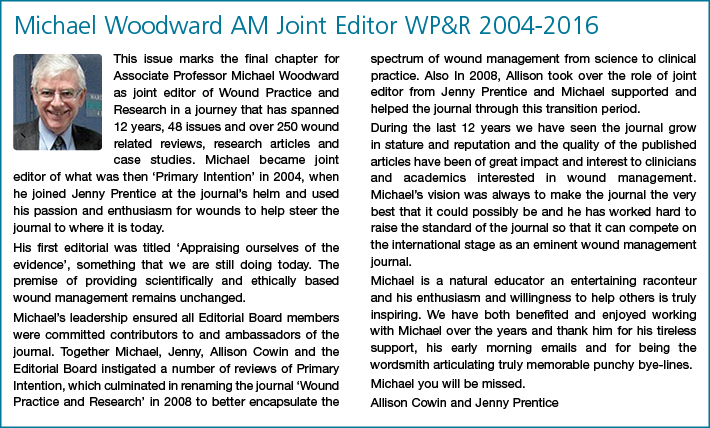Wound infection is a complication that can be more than inconvenient. Depending on the person, a wound infection can impact on their well-being, income from loss of work, body image and even threaten limb or life. Millions are spent globally on treating wound infection and lives are lost each year. So how do we improve practice, how do we know what to look for, how do we understand what is happening at a molecular level that influences what we do or don’t do and how much does the person with a wound influence what the outcome is? This edition focuses on these topics from the basics of wound care to hopes for future innovations in treating and diagnosing wound infection.
A summary article of the 2016 International Wound Infection Institute Wound Infection in Clinical Practice Consensus Document is included in this edition. Matt Malone and Annie Walsh provide a perspective on learning and gaining insight into the paradigm of biofilm.
Dr Emily Haesler, who has a wealth of knowledge in searching for and reviewing wound management evidence, and her co-authors worked with the Wounds Australia team on the literature review for the consensus document that will be released in 2017 regarding aseptic technique for a wound dressing procedure.
Malik Hussain’s team provides interesting information on anaerobic bacteria in wounds, which is interesting and thought provoking. When doing standard wound cultures, we are not necessarily testing for this and is time to change practice?
A/Prof Geoff Sussman reminds us of the importance of antimicrobial stewardship in his article on antibiotic resistance. And from the USA, Prof Greg Schultz et al inform from the laboratory the latest information on biofilm and some promising research of topical agents for the management of biofilm.
Our journal watch by Dr Charne Miller reviews three articles that inform and challenge.
Clinicians still need to do the basics well. We need to take the TIME to do it right. Prevention is the key so basics such as hand hygiene, aseptic technique, therapeutic wound cleansing and appropriate topical management are the foundation to provide optimal outcomes.

Author(s)
Terry Swanson
NPWM FAWMA



